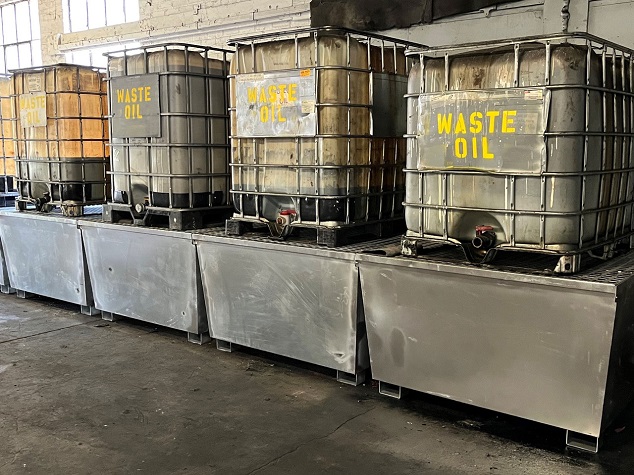Contents
Any business dealing with large quantities of liquids and chemicals places the importance on spill containment solutions. Drums and tanks containing hazardous substances are a safety risk for employees, the immediate workplace, and wider surroundings, so they need to be stored on relevant bund spill pallets. These go underneath drums and other storage units and have the adequate capacity to contain all the contents in the event of a leak or large-scale spill.
What is a Bunded Pallet?

This piece of workplace safety and spill containment equipment goes by different names. Whether you find them as high quality bunded pallets or drum spill pallets, spill trays or IBC spill containment pallets, or even portable bunding, they all mean the same thing. They’re the type of equipment created to hold drums and containers storing hazardous or toxic liquids.
Each bunded pallet has a simple design, basically a platform and liquid-tight base made of durable, lightweight and chemically resistant materials. Most usually include dispensing trays or funnels to safely remove liquids, and pockets for quick transport with a forklift. Pallets can be optioned in 1 to 4 drum configurations and in varying sizes and designs.
Why Are They Necessary?
Spill containment pallets are a legal necessity, and several Australian standards (AS 1940–2004, AS 4326–2008, AS 2714–2008, AS 3780–2008, AS 2507–1998, and AS/NZS 4452–1997) regulate their use in workplaces that deal with dangerous goods. Additionally, bunded pallet sumps must contain 110 per cent of the largest container or 25 per cent of the total stored. Not abiding by set rules can result in fines of up to $30,000.
Besides legal requirements, these pallets help in general workplace safety and secondary containment. They reduce the likelihood of injuries, lower the risk of exposure to hazardous substances, prevent property damage, and avoid larger environmental fallout. If a spill does happen, the bund pallet makes cleanup easier and quicker, without affecting daily proceedings or requiring the use of expensive spill kits and equipment.
Where Are Spill Pallets Used?

Industries and businesses that store, handle or transport large quantities of hazardous materials and liquids all use these specific pallets. This includes chemical plants, manufacturing facilities and warehouses where solvents, acids, and corrosives are used.
These spill containment equipment pieces are also present in the oil and gas industry to safely store oil, lubricants, fuel and refined products, most often in drums. They’re additionally seen in the pharmaceuticals business, agriculture and farming, warehouses and distribution centres, laboratories and more. And they’re used with containers, drums and tanks to ensure they’re transported safely.
Spill Pallet Sizes
Sizes will vary depending on the number of drums or containers that need to be stored. The 2 and 4-drum variants are more common, and can safely capture and contain the contents of standard 240-litre drums. There are also bunds for single drums (in varying capacities), and those that can fit three drums abreast to allow for easier handling and transport.
Polyethylene or Steel Spill Pallets?

Since they need to contain oil, chemicals, acids, fertilizers, and other hazardous or toxic substances, spill containment bunds must be tough. Most are made of reinforced plastics, specifically polyethylene. This is used to store organic peroxides, corrosive and toxic substances and oxidising agents. If there’s a need to store flammable or combustible liquids, the bunds are made of steel. Polyethylene is the more abundant material in day-to-day operations, whereas heavy-duty applications require the use of steel.
Choosing the Right Bunded Pallets for Your Application
There are several factors to consider when buying bunded pallets:
- Capacity – pallets need to be of the right size and capacity to contain all the liquids if a leak or spill happens. Here you need to consider the number of drums or containers the pallet holds, and their overall capacity while abiding by general guidelines,
- Drainage – to easily capture and contain any spilled liquid, the bund must also have proper drainage.
- Materials – As mentioned, polyethylene will cover most stored substances, but for highly toxic, flammable and hazardous substances, choose bunds made of steel.
- Transportation – Will the pallets be used solely to store liquids in a designated place, or will they need to be moved around? Consider pallets that have pockets for forklift tines or wheeled versions for easy transportation within the worksite and beyond.
- Compliance – Make sure you abide by spill containment regulations for your industry. This minimises risks and the likelihood of severe injuries.
Summing Up
There are multiple reasons why you need the appropriate drum spill pallets for your workplace. They are designed from tough, anti-corrosive and chemically resistant materials that prevent spills from wreaking damage to the environment. They’re also created with worker safety in mind by preventing slips, injuries and exposure to hazardous substances, and they help keep the workplace clean and free of damage.
They come in various sizes, in medium and heavy-duty variants, with additional features for simple operation and in outdoor and indoor types. Plus, they comply with set rules and guidelines for the respective industries in which they’re used. Bunds are readily available from material handling stores, reasonably priced and a must-have for any business working with hazardous liquids.




Comments are closed.